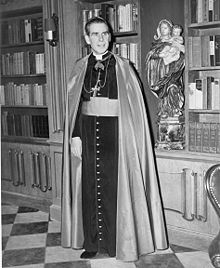Ferraiolo

The ferraiolo (also: ferraiuolo , ferraiolone ) is a type of cape that is traditionally worn by clerics of the Catholic Church on formal, non-liturgical occasions. It can be worn over the shoulders or behind the shoulders, reaching to the ankles and is held together at the front by a loop made of narrow strips of fabric. It has no trim or embroidery.
status
The color of the Ferraiolo is determined by the rank of the cleric. Simple priests wear black, while protonotaries and bishops wear purple and cardinals wear scarlet moiré . A ferraiolo made of moiré also identifies the wearer as an apostolic nuncio or a member of the papal family . The Pope does not wear a Ferraiolo.
In addition, the Premonstratensians (Norbertines, "white canons"), Camaldolese , members of the orders of Our Lady and the Holy Trinity as well as the Olivetans and some other orders have received the privilege of wearing a white Ferraiolo. The Premonstratensians also have a square biretta made of the same material. Regular canons are allowed to wear a choir shirt and the Rochett even on non-liturgical occasions, but without the Ferraiolo. The canon of the Premonstratensian, as a priest, deacon or seminarist, may wear the ferraiolo, cingulum / sash with fringes and biretta (without bobble) made of white fabric. This is how they differ from the secular priests. The Premonstratensian abbots (Abbas regiminis and Abbas nullius) are allowed to wear a ferraiolo made of moiré as well as a pectoral cross and the ring with their habit. Outside of their own monastery, they are allowed to wear a Mantelletta with these status symbols , but without the Ferraiolo.

development
The Ferraiolo is originally a clothing item used by Roman society for citizens. It was usually knee length. The simplification of clerical robes in the Catholic Church after the Second Vatican Council was published in three documents which reflect the current legal situation. The first of these is the instruction of the State Secretariat of March 31, 1969 Ut sive sollicite , on clothing, titles, coats of arms of cardinals, bishops and prelates. The second is the Circular of the Sacred Congregation for the Clergy of October 30, 1970 Per Instructionem , on the reform of the choral clothing. Therein the rules are extended to canons, beneficiarii and pastors as well as to all other categories of clergy. The new Caeremoniale episcoporum (CE) deals with a systematic list of the forms of clothing based on and supplementing the regulations of the first two documents . Nainfa's Costume of Prelates of the Catholic Church provides the best presentation, which also deals with cases not included in the aforementioned documents .
literature
- John Abel Nainfa: Costume of Prelates of the Catholic Church: According to Roman Etiquette. John Murphy Company, rev. ed.Baltimore 1926.
Web links
Individual evidence
- ↑ Ceremonials of the Bishops, Cæremoniale Episcoporum. Congregation for Divine Worship and the Order of the Sacraments , September 14, 1984, p. 1205.
- ↑ AAS 61 (1969), therein page 334 ff. Instruction Ut sive sollicite (original publication with authoritative text; PDF; 4.1 MB)

